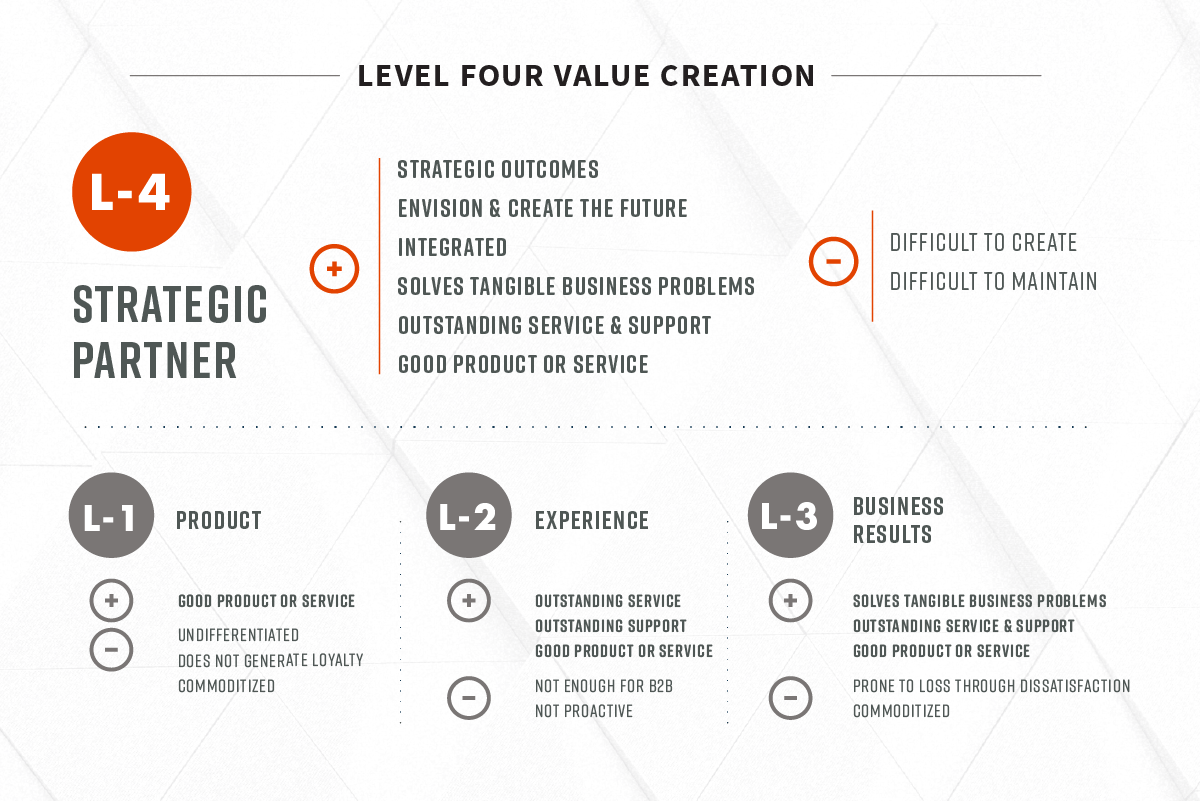Inside the sales conversation, there are four levels of value:
The first level of value is the conversation is sharing information about your product or service. While it's important to offer something good, starting the conversation with your product or service makes your contact treat you like a commodity.
The second level of value is the conversation about your support, your service, and the experience your company provides. It's important that the client has a good experience and the support they need, but in B2B sales, this is table stakes. Most decision makers don't find this conversation to be valuable.
The third level of value is a conversation about the execution of whatever it is you sell. For example, if you sell transportation, the conversation is about how you will ensure the client's shipments make get to the right party. This is the highest level of conversation you find in a "solution" sale. And, as you can see, it brings the conversation back to the product and service.
The fourth level of value starts the conversation with the strategic outcomes and works backward. This is where the One-Up sales conversation begins. The transportation company's clients don't want shipping; they want their customers to receive their orders on time. The client also wants a reduced cost versus what they would have to pay to do it themselves. They may even want the transportation company to act as a third-party logistics company and handle the process, leaving the client to focus on selling.

Being One-Up
Here are two different approaches to the sales conversation:
- The salesperson asks their client about a problem because it allows the salesperson to suggest that their solution is just what the client needs.
- The salesperson asks the client a question about one of the very few problems they can solve, already knowing the problems and their root causes.
In the first case, the salesperson needs a way to introduce their solution. In the second case, the salesperson is compelling change. Think of it this way: Why would a salesperson call a perfect stranger and ask them for a meeting if they didn't already suspect they could improve their results in some meaningful way? By starting the conversation at the fourth level of value, the strategic value, you position yourself as someone with the ability to help the client improve their results.
Fortunately, there is more than one way to elicit a client's problems, especially when you already know what problems your clients are experiencing and why. There is a difference in asking a client to tell you about their problem and asking a question that teaches them something about their problems.
Here is a fourth-level question that would teach the client something about their problem:
"What is your plan to help your sales force make the behavioral changes that would ensure your team is able to adopt a new approach?"
This question moves past the first three levels, all of which are important, and gets to a strategic outcome.
The Problem with Level Three
I know it makes some salespeople sad when I suggest that their solution is the best in the world—just like their competitor's solution. I offer no apology for speaking the truth. Those who have lost a prospective client to a competitor with a lesser solution must eventually understand that the solution may not have been the most important variable the client considered when making that decision.
If you understand that the salesperson who pitches the client to buy their solution in the first five minutes of the sales call is different than the one who does the discovery that uncovers a problem, then you can understand that the distance between level four and level three is an order of magnitude greater than the distance between level three than three and level one. Each step up increases the value you create for your client in the sales conversation.
The reason you lose deals to salespeople with a solution you believe to be inferior is because the salesperson created more value within the sales conversation. The salesperson that won differentiated themselves and possibly their solution more effectively.
There is an old saying about leadership that says, "Better a lion leading an army of sheep than a sheep leading an army of lions." Let us make an adjustment to this insight: Better a One-Up salesperson selling an inferior product or service than a One-Down salesperson selling a highly differentiated and greater value-creating product or service.
The Nature of Consultative Sales
Without suggesting a consultative salesperson doesn't learn from every client interaction, it's important to know that a consultative salesperson, one that is One-Up, knows more about their client's problems and challenges than their client does. A client that knows everything they need to know to improve their results doesn't need additional counsel.
In the sales conversation, your salesperson needs to create value for the client by providing counsel, advice, and recommendations. Any approach that is not built on that idea cannot create the value required to establish a preference to buy from the salesperson.
There is nothing consultative about asking the client about their problem if the only aim is to introduce your solution as the right choice for them. This is how and why level three has been completely commoditized. It's also why good salespeople have ditched the legacy approach to sales, replacing it with a conversation clients find more valuable.
One way to remove the legacy strategies is to use a consultative sales approach, one in which you recognize your obligation to help your client make a decision that will improve their strategic outcomes. This helps you avoid selling at a level that would have your client treat you—and what you sell—as a commodity.











